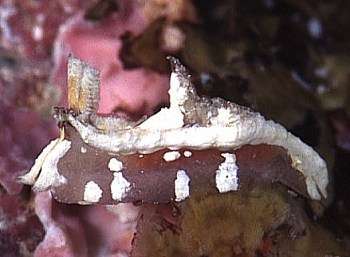
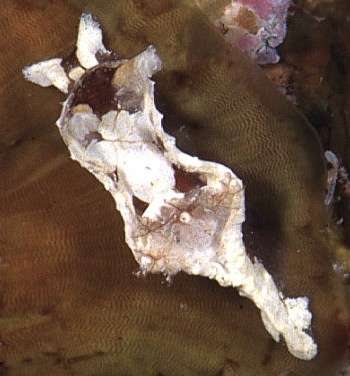
Goniodoris felis
Baba, 1949
Order: NUDIBRANCHIA
Suborder: DORIDINA
Superfamily: ANADORIDOIDEA
Family: Goniodorididae
DISTRIBUTION
Known from Japan and Hong Kong.
PHOTO
10mm long, Kerama Is.[near Okinawa], 15m, Japan, May, 1999. PHOTO: Atsushi Ono.
The colour is quite distinctive with an opaque white head and dorsum and gills with a few dark brown patches. The sides of the body are translucent clear with some brown and white mottling. It grows to at least 20mm in length.
References:
• Baba, K. (1949) Opisthobranchia of Sagami Bay. Iwanami Shoten: Tokyo.
• Rudman, W.B., Darvell, B.W. (1990) Opisthobranch Molluscs of Hong Kong: Part 1. Nudibranch Families; Goniodorididae, Onchidorididae, Triophidae, Gymnodorididae, Chromodorididae. Asian Marine Biology, 7: 31-79.
Rudman, W.B., 1999 (September 11) Goniodoris felis Baba, 1949. [In] Sea Slug Forum. Australian Museum, Sydney. Available from http://www.seaslugforum.net/find/gonifeli
Related messages
Juvenile Goniodoris felis from Japan
July 2, 2008
From: Ayumi Murakami
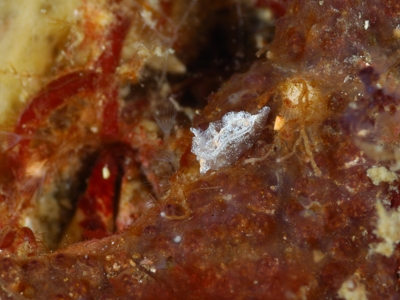

Concerning message #13112:
Dear Bill
I have observed some animals that look like Goniodoris felis. Also there were a lot of smaller animals around them.
My pictures are approx 12 mm wide. I guess from it, the smaller animals are under 1 mm, nearer 0.5 mm. The bigger animals are 2-2.5 mm. In the middle picture, taken one week after the lower one, at the same place, the animals are a little bigger.
Locality: Izu Peninsula, 6 m, Japan, Pacific Ocean, 11, 17 May 2008, on the buoy on sand. Length: 2 mm and under 1 mm. Photographer: Ayumi Murakami.
I guess they live with the group until they are bigger, because at around 2-4 mm each can survive independent of the group in a slightly different environment, for example on seaweed. They were on a buoy under 6 m of water. It was with a lot of sponge, hydroids, bryozoans and seaweed.
Do you think that they are parents and offspring? or just gathering to feed?
Best Regards
Ayumi Murakami
umiushi2@masea.info
Ayumi Murakami, 2008 (Jul 2) Juvenile Goniodoris felis from Japan. [Message in] Sea Slug Forum. Australian Museum, Sydney. Available from http://www.seaslugforum.net/find/21664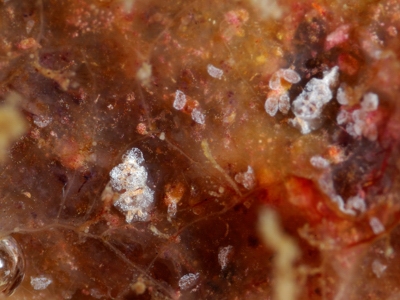
Dear Ayumi,
Thanks for these interesting photos. We still have much to learn about the early life history of most nudibranchs. I am not sure if Goniodoris felis has a free-swimming veliger larval stage or whether it is direct developer in which small crawling young hatch out of the egg mass.
The tight clustering of the juveniles in your photos would suggest to me that these juveniles are direct developers which have recently hatched out of an egg mass which was attached nearby. One problem with that idea is that we have messages from Dong Bum Koh's [see #12932] showing possible egg masses of G. felis, but the eggs look a bit small for direct developers. It's possible your juveniles are a cluster of recently settled planktonic larvae which have been attracted to a colonial bryozoan, which presumably is the food of Goniodoris. Basically we will need to confirm the type of egg ribbon this species produces, and confirm what type of development its larva have.
As to whether these are parents and babies. Even the large ones are quite small so I would suspect that these are all juveniles, with the larger ones a few weeks older than the smaller ones.
Best wishes,
Bill Rudman
Goniodoris species from South Korea
February 10, 2005
From: Dong Bum Koh

Dear Bill,
Thank you very much for your kindly identification [message #12932] of Goniodoris felis in the Forum.
Now I'm confused about some Goniodoris specimens which were taken during last year in Jeju areas with my Eco-Diving Club. Could you let me know about these animals?
All photos were taken Sasu Harbour (Fishery small harbor near Jeju city = Northern Coast of Jeju island) during night diving. Sth Korea. Depth: approx 6 m.
Photos 87, 98 [10 June 2004], 86 [14 June 2004], 09 [02 July 2004] Photographer : Sang Yual Shin.
Photo 45 [02 July 2004], 11 [10 June 2004] Photographer : Byung Ro Youn
Best regards,
Dong Bum Koh
drkoh@seasee.co.kr
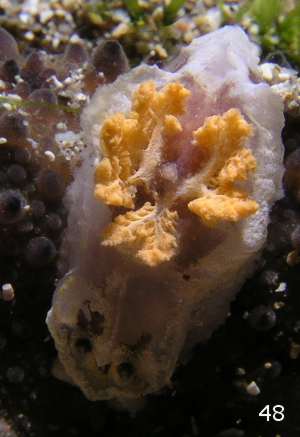

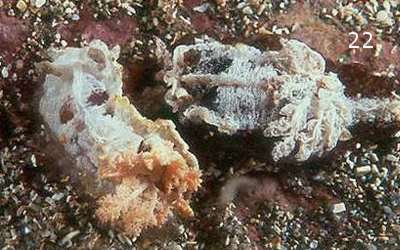
Dear Koh,
These photos in fact make my job easier. They are almost certainly colour variations of one species. You'll note the dark brown patches vary in intensity, and in some specimens, such as Photo 48, the brown is absent around the gills and what can be seen is the viscera showing through the translucent body wall. The gills are very 'bushy' in this species and also show colour variability from orange and brown to white.
I may be wrong, but I think these animals are the same species as those in your earlier message, which I am pretty sure is Goniodoris felis.
Best wishes,
Bill Rudman
Goniodoris felis from South Korea.
February 7, 2005
From: Dong Bum Koh
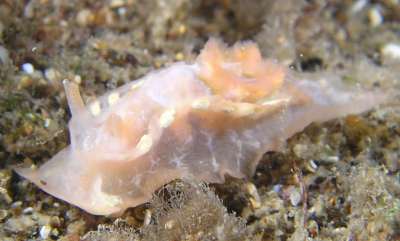
Dear Bill,
Here are some photos of Goniodoris sp. taken during a night dive. One shows an adult crawling, the other of an animal in its egg ribbon.
In a separate message [message #13082] there are photos of Goniodoris laying eggs and two Favorinus tsuruganus eating the eggs.
Locality: Jeju Island. Hwa Soon Beach, South Korea. Depth: 4 m. Length: 30 mm. 19 Dec. 2004. Sandy bottom with Rock. Photographer: Youn Byung Ro
Dong Bum Koh
drkoh@seasee.co.kr
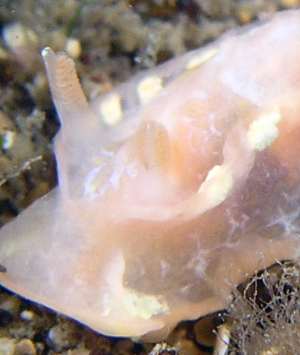
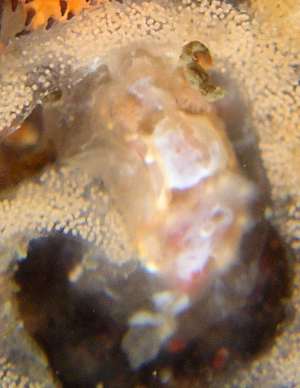
Dear Koh,
Thank you for these interesting photos, which I have split into 2 further messages, one showing Goniodoris and its eggs [message #13082], and another showng them being eaten by Favorinus tsuruganus [message #13000 ].
But firstly I would like to discuss the identity of this species. I think it is a pale form of Goniodoris felis. It is very similar to the painting accompanying Baba's original description of this species. Often this species has a pattern of dark brown patches, which are very small in the original painting. What this Korean animal has is the characteristic pattern of opaque white patches on the mantle. It also has a number of large opaque white masses around the mantle edge which I assume are glandular. These can't be seen in other photos on the Forum because the edge is usually all opaque white, but the white patches seem to match bumps which can be seen along the edge in other photos.
Best wishes,
Bill Rudman
Eggs of Goniodoris felis from Sth Korea
February 7, 2005
From: Dong Bum Koh
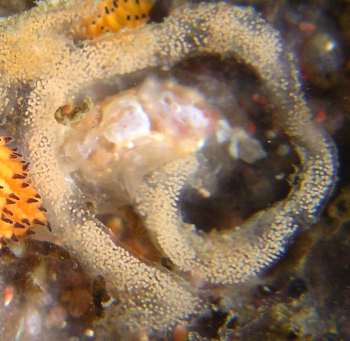
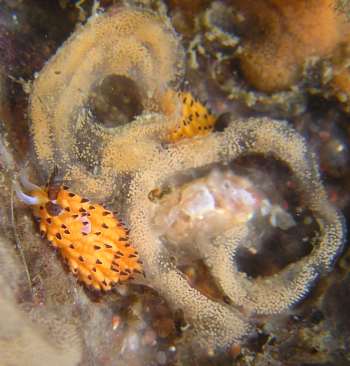
Dear Bill,
To accompany my photos of Goniodoris sp. [message #12932], here are some showing the egg ribbons. Two Favorinus tsuruganusare eating the eggs.
Locality: Jeju Island. Hwa Soon beach, South Korea. Depth: 4 m. Length: 30 mm. 19 Dec. 2004. Sandy bottom with Rock. Photographer: Youn Byung Ro.
Dong Bum Koh
drkoh@seasee.co.kr
Koh, D.B., 2005 (Feb 7) Eggs of Goniodoris felis from Sth Korea. [Message in] Sea Slug Forum. Australian Museum, Sydney. Available from http://www.seaslugforum.net/find/13082Dear Koh,
Thanks for these photos of Goniodoris felis and its egg ribbons. I guess the greyish material in the background of the photo is the remains of a compound ascidian that the Goniodoris has been feeding on. From my experience with other species, they usually lay their eggs on their food. Favorinus tsuruganus seems willing to eat a wide variety of opisthobranch eggs. I have included some close-ups of Favorinus separately [message #13000].
Best wishes,
Bill Rudman
Goniodoris felis from Hong Kong
February 6, 2002
From: Bill Rudman & Brian Darvell
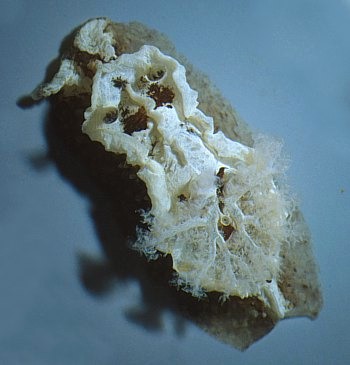

Here is some information and photos on Goniodoris felis from Brian Darvell's Hong Kong collections.
The colour is quite distinctive with an opaque white head and dorsum and gills with a few dark brown patches. The sides of the body are translucent clear with some brown and white mottling. Specimens were 17 mm long preserved.
PHOTO:
AM C 139196, 15 April 1983, Site 2.67, Kai Kung Tau, Kat 0 Chau, Mirs Bay, 5-10 m, Hong Kong. Photos: Brian Darvell.
Hong Kong Collection Records:
AM C 139196, 15 April 1983, Site 2.67, Kai Kung Tau, Kat 0 Chau, Mirs Bay, 5-10 m. AM C149771, 16 March 1986, Site 11.87, South Ninepin (SE), 17 m. AM C150297, 2 specimens, 9 April 1986, Site 4.134, Cha Am Pai, Mirs Bay, 10 m. AM C150298, 14 April 1986, Site 4.8, Breaker Reef, Mirs Bay, 6 m. Depth range: 5-17 m.
Reference:
• Rudman, W.B. & Darvell, B.W. (1990) Opisthobranch molluscs of Hong Kong. Part 1. Goniodorididae, Onchidorididae, Triophidae, Gymnodorididae, Chromodorididae, (Nudibranchia). Asian Marine Biology, 7: 31-79
Best wishes,
Bill Rudman & Brian Darvell
Goniodoris felis from Philippines
June 17, 2001
From: Jeff Rosenfeld

Hi Bill,
Here's another shot taken in Anilao, Luzon Island, Philippines in April,
2000 which I believe to be Goniodoris felis. The individual that I found was tiny (approximately 6-8mm) and a rather bright yellow.
Jeff
The Vibrant Sea
jhrosenfeld@seattleschools.org
Rosenfelld, J., 2001 (Jun 17) Goniodoris felis from Philippines. [Message in] Sea Slug Forum. Australian Museum, Sydney. Available from http://www.seaslugforum.net/find/4577Dear Jeff,
This is quite possibly Goniodoris felis. I am preparing some photos from Hong Kong, which shows that not all specimesn of this species are as dark as the one in Atsushi's photo.
Best wishes,
Bill Rudman
Goniodoris felis from Kerama Is.
September 12, 1999
From: Atsushi Ono


Dear Bill,
Thank you for helping with my unidentified aeolid.
Now, I found Goniodorid species at Kerama Is. [near Okinawa] in Japan.
It has white patches and lines on its translucent body. I found this at 15m depth, 10mm long, in May, 1999.
Could you help me to identify this one?
Sincerely,
Atsushi Ono
ononini@cosmos.ne.jp
Ono, A., 1999 (Sep 12) Goniodoris felis from Kerama Is.. [Message in] Sea Slug Forum. Australian Museum, Sydney. Available from http://www.seaslugforum.net/find/1328Dear Atsushi,
This is Goniodoris felis which was described by Baba from Sagami Bay. The one specimen and coloured illustration he had available were of quite a pale specimen. Your animal and the ones I have seen from Hong Kong (Rudman & Darvell, 1990: Pl 1B) have more dark brown on the dorsum.
Have you found this species often? If so is it associated with any food item. Species of Goniodoris are often found on the colonial ascidian colonies they eat. Because their bodies are partly transucent and partly pigmented with shades of brown and white they are usually very well camouflaged. As I have shown with Goniodoris meracula they also often live in cavities they eat out of the ascidian colonies, which only makes them even more difficult to find. As with many cryptic species, the egg masses are the best clues to their presence.
best wishes,
Bill Rudman.
